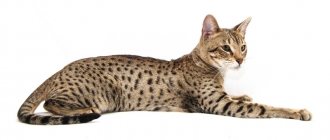Cornish Rex cats are real English aristocrats of the cat family. Thin-legged, graceful creatures with unusual wavy fur and expressive eyes have won the hearts of many. Don’t let their external fragility and soft curls fool you: Cornish cats, despite their fragility, are quite playful and active. Get to know the Cornish Rex cat breed: curly-haired smarties, athletes and simply beauties.
History of origin
The Cornish Rex breed appeared not so long ago. The first written mentions of kittens with unusual skin date back to the 20s of the last century. Due to lack of education and fear of losing all their animals, owners often destroyed the cat's litter.
Only in 1950, a Cornish farmer decided to keep an unusual kitten. Having contacted a famous geneticist, she began crossing cats to obtain a new mutation. The first Cornish Rex, nicknamed Kallinbunker, and then his children became the founders of a new breed.
Selena and Kallinbunker were put to sleep by their owner due to financial problems. And their children were transported to America in 1957, where they became the founders of the American branch of the Cornish.
The breed received worldwide classification and standards in 1983.
Cats have such an unusual coat due to a gene mutation. To avoid degeneration, experts crossed Siamese cats, British Shorthairs and Cornish cats. Nowadays, the breed is considered mature and mating of Rex with other species is prohibited.
Breeding
When breeding this breed, it is necessary that both sexes have the same species and the same color, fully consistent with the breed standard. Otherwise, the gene responsible for the special coat may not appear due to its recessivity.
According to the rules, mating is carried out during the cat’s third heat, and the cat must be at least 9 months old. The female spends 4 to 6 days with the male, preferably on his territory. Before mating, deworming should be carried out. If after a month the heat does not recur, then the cat is fertilized.
Attention! A litter can have from 3 to 6 kittens. Their birth weight is about 100 grams.
Pregnancy in females lasts from 60 to 65 days. They give birth easily, there are no difficulties. Cats become excellent parents and carefully care for their offspring. These babies need to be kept warm. Short fur will not be able to warm them. The curliness on it is weakly expressed. But by 10 months, after molting, the hair characteristic of this noble breed appears.
Description of the breed
Thanks to a mixture of different breeds, the Cornish Rex is distinguished by the fine bones, grace and energy of its ancestors. The established breed standard is not strict:
- A narrow skeleton, having the same width in both the chest and pelvis;
- Long, tapering tail;
- High, graceful legs;
- The hind legs are much longer than the front legs;
- Narrow triangular muzzle, with a humped bridge of the nose;
- Almond-shaped eyes, slightly slanted;
- Large ears set wide and high;
- Well-defined chin.
Health, tendency to disease
Corinche Rex cats are distinguished by good health; a possible reason for good immunity is a slightly elevated temperature (38.5-39 ° C). No genetic problems (breed diseases) were found. The most common types found in rexes are:
- skin diseases (dermatitis),
- colds and respiratory diseases,
- gastrointestinal disorders,
- cystitis (inflammation of the bladder).
Animals tend to overeat, which can cause obesity. Cornish Rexes are very sensitive to anesthesia drugs, therefore, unlike cats of other breeds, they take longer to recover from anesthesia. An overdose of sedatives used before surgery can cause complications: deafness, neurological disorders, damage to brain cells, and death.
It is recommended to have a first aid kit for your cat. Need to buy:
- cotton wool,
- cotton buds,
- elastic bandage,
- gauze,
- patch,
- brilliant green,
- iodine,
- hydrogen peroxide,
- Activated carbon,
- Vaseline oil (Vaseline),
- scissors with blunt tips,
- tweezers,
- eye dropper,
- rectal thermometer,
- syringes, incl. insulin,
- ammonia,
- boric acid powder,
- streptocide powder.
Vaccination
They begin when the kitten is 8 weeks old. First you need to rid the animal of fleas and ticks, then deworm it. The remedy for parasites is given 10-12 days in advance. before vaccination. First, they are vaccinated against panleukopenia, calicivirus and rhinotracheitis. Revaccination is necessary after 2-4 weeks, then 1 time per year.
Starting from the age of 12 weeks, they are given a rabies vaccination (once), revaccination – annually.
After 2-3 weeks. The kitten is vaccinated against fungal diseases. 2 injections are required, with an interval of 10-14 days, revaccination - every year.
Quarantine after vaccinations should last 10 days, during which it is important to protect the baby from:
- overheating,
- hypothermia,
- strong physical activity,
- long transportations,
- contact with other pets,
- suspected sources of infection (for example, street shoes).
Curly cats
Cornish Rex are sometimes called Astrakhan Rex because their coat is reminiscent of the wavy Astrakhan sheepskin coats that our grandmothers wore. Such wavy richness looks great from the outside, but in reality, pets freeze and suffer from drafts.
The coat of this breed consists only of dense, fluffy undercoat without long protective guard hairs. Thick, curly fur is pleasant to the touch. Kids love to squeeze fluffy balls.
The fur should be uniform and dense. On the neck, stomach and inside of the paws it is shorter and less frequent. Corniches have a strict point about the thickness of the coat. Bald patches found on a kitten’s body will immediately classify it as illiquid. Interspersed with long fibers are also a deviation from the standard.
Cornish Rexes do not shed like regular cats. At a time when other owners suffer from an excess of hair in the apartment, on things, carpets, Cornish owners can simply give their pet a bath.
Important: Remember, when choosing a Cornish Rex, pay attention to the color of the mucous membranes, nose, paw pads and eyes. They must match the color scheme. Black, blue Rexes have only dark mucous membranes and dark eyes. The exception is Siamese kittens: they have blue eyes. If you are offered a wavy baby, but his paw pads and nose are pink, you are being deceived!
SIGNS OF APPROACHING BIRTH
Throughout pregnancy, the cat arrives in a calm state, sleeps a lot and eats well. The cat's belly does not allow her to be active and jumping as before.
On the day of birth, your pet's behavior changes radically, so you will immediately understand that this day has come. The cat becomes restless, endlessly walks around the apartment or after the owner, refuses to eat and may scream unnaturally. These are signs of childbirth in a cat. More precisely, the first stage of labor is contractions, which can last up to 12 hours and are accompanied by bloody discharge from the vagina.
Complications in the process are also possible. For example, if your cat cannot give birth to her first kitten 6-7 hours after her water breaks, or if the kitten is stuck in the birth canal (and this unfortunately happens), call the veterinarian, because The cat needs help. An unresolved placenta is also a serious cause for concern, because... this is the cause of possible subsequent inflammatory processes in the cat.
British cats, like Scottish cats, should give birth for no more than 24 hours in total from the moment contractions begin. But most often they pass faster - 5-7 hours, depending on the number of kittens.
During this period, it is best to be nearby, stroke your pet, massage her tummy.
The second stage is the actual appearance of the kittens. The kitten should come out of the birth canal with its head (but it often happens the other way around). It appears in the amniotic sac, which the cat must bite through and gnaw through the umbilical cord. Sometimes the cat does not have time to do this if the next kitten is already on the way. This happens very often, because... the interval between the appearance of kittens can be only 5 minutes. At such a moment, the cat is not able to release and lick the already born one. This is where your help will be needed. Free the baby from the bladder yourself and carefully wipe it; if the umbilical cord is long, then cut it with scissors, leaving a length of 1.5-2 cm from the kitten’s abdomen. Treat the edge of the umbilical cord with any antiseptic. Examine the kitten, listen to its breathing, it should be uniform. If this is not the case, then the kitten has inhaled amniotic fluid and it has entered the lungs. Gently tilt it head down and hold it until it beeps. Check the kitten's tongue, it should be pink, which means normal breathing and sufficient oxygen in the body.
During the birth process, put the kittens in one specific place yourself. When it's all over, present your cat with a box of kittens, the box should be spacious so that she can lie next to them and feed them.
A cat's behavior after giving birth can sometimes be completely unpredictable. It happens that at first the cat refuses to feed the babies or does not approach them at all. There is nothing wrong with this, it’s just that the “new mother” has not yet gotten used to them and has not realized her role. You just need to help her a little: place the kittens next to her with their muzzles to the nipples. It’s better not all at once, but gradually, one at a time. The kittens have her scent and she will start licking them anyway and “recognizes” them. If the kittens start eating, then everything is fine. Praise your pet, even better, sit next to her while she feeds, stroke, caress her. Bring her her favorite food and milk or sour cream directly to the rookery. After all, a cat after giving birth for the first time can lie next to the kittens for almost a day without even leaving to go to the toilet or to the bowl. And after such a big undertaking, you need to gain strength. In general, further nutrition should be enhanced and contain more dairy and fermented milk products.
Features of communication
Cornish Rexes are very active and friendly. They are great companions. This breed is ideal for those with small children. Energy, playfulness and peacefulness will surprise anyone. And even when the child is already tired, these wavy fidgets, after resting for a couple of minutes, can continue playing.
If they usually say about cats that “they walk on their own,” then Cornish cats are a pleasant exception. They love communication, games, running around. Cats of this breed are always close to their owner. If desired, they can be taken outside; a leash is needed for this. Experienced breeders recommend accustoming babies to this accessory from the age of four months.
If strangers visit the house, Cornishie will have no problem keeping company and will even sit on his knees to warm up. One can only envy their sociability and socialization.
Recommendations for choosing a kitten
If the decision to get a Cornish Rex has been made, then first you need to decide on the gender of the animal, because the temperament of male and female individuals differs. Cats are calmer and more attached to their owner; cats are curious, active and restless, but at the same time they are very affectionate.
To choose the right kitten, you should use the following expert advice:
- buy a baby in specialized nurseries or from trusted breeders, this is the only way to avoid getting a sick or out-of-breed animal;
- obtain maximum information about parents, evaluate their behavior, socialization, health;
- take the kitten home only when it reaches 2.5-3 months, so that by this time it has learned the necessary life skills from its mother and becomes independent;
- examine the kitten for diseases and defects (discharge from the nose and eyes, cleanliness of the ears, the presence of fleas, ticks, quality of fur and skin, size and softness of the abdomen, etc.);
- check the accuracy of the documentation (certificates of origin, permission to obtain a pedigree, veterinary passport indicating all vaccinations and the date of their implementation).
The price for representatives of the breed varies from 25,000 rubles for pet-class individuals, subject to mandatory sterilization, to 50,000 rubles for show-class babies who can take part in exhibitions. If a kitten is purchased for further breeding, then its cost usually does not exceed 30,000 rubles.
Nutrition and care
Many people believe that without long hair, a cat does not need careful care. This is absolutely not true. Like any cat, the astrakhan beauty sweats and gets dirty. To keep the skin shiny and not matted, Cornish needs to be washed once a week with a special shampoo. Without water treatments, the skin becomes covered with scales, begins to itch and becomes inflamed.
Choose combs only with natural bristles. Short, curly hair can be pulled out by the roots under strong pressure, which can lead to baldness. In addition to combs, a special mitten is an excellent way to remove dead hair.
Touchingly protruding ears also require constant care. Once a week, you should wipe the auricle with a damp cotton swab or swab lubricated in Vaseline oil. Dirt and dust accumulated at the bottom of the sink can cause discomfort to the kitten.
Nail trimming should be done once a month using special nail clippers. Only 2 millimeters of the transparent keratinized part of the claw is cut off so as not to damage the nerve endings.
Nutrition
Cats of this breed are not picky eaters. Like any animal, they require a normal balanced diet to function normally. The presence of vitamins and minerals is the key to the normal development of muscles, skeleton and a healthy appearance of the cat’s skin.
Active and energetic games require a lot of effort. Cornish Rex are always hungry. They can eat up to five times a day. But, it is worth accustoming them to eating at the same time in the morning and in the evening, otherwise very soon they will gain excess weight.
Of course, the owner will decide what the Cornish Rex will feed on. Selecting a diet from natural products or dry balanced food is a controversial issue. Nutritionists consider a mixed diet not advisable, since different amounts of enzymes are needed during the digestion of different foods. Although veterinarians and breeders consider mixed feeding to be the most optimal.
To select a menu made from natural products, it is worth including:
- Chicken meat;
- White fish;
- Vegetables;
- Cereal porridge;
- Cottage cheese, unsalted cheese, kefir;
- Boiled eggs, liver.
Important: If a male lives in the house, you should give up fish and seafood in your diet. Their consumption can lead to the formation of sand and kidney stones. Accordingly, problems with the kidneys and urinary tract.
If you take good care of your cat and choose the right diet, the Cornish Rex can live up to twenty years. On average, the lifespan of wavy cats is 14-15 years.
How long do Cornish Rex live?
By cat standards, representatives of this breed have a decent lifespan. With an average lifespan of 15 years, they often live up to 20 years. It is incredibly lucky that the Cornish do not have any genetic diseases. And this despite the fact that the breed appeared through inbreeding. The animal has good health and strong immunity. If these short-haired cats are not exposed to hypothermia, which can cause respiratory diseases and cystitis, then your pet will live happily ever after.











